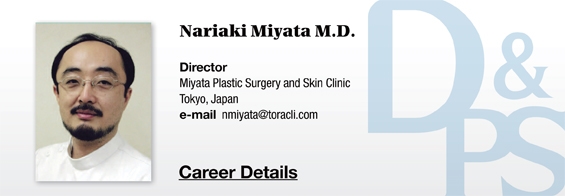
Let us now look at combination treatments used in skin sagging in Japan.
As our knowledge on the process of facial aging improves, treatments of age-related skin sagging are evolving. We are veering away from simply correcting the skin or SMAS to addressing volumetric changes of the bone and soft tissues in our treatments. Many doctors still believe that the face lift is the most effective method for correcting sagging skin. However, lifting the SMAS is not sufficient to bring a rejuvenated appearance in Asians who generally have a pronounced zygomatic arch and a flat facial surface. A sufficient lift would only be achieved with correcting the retaining ligaments as well, which would make for an invasive surgery. Many members of JSAPS thought surgery was the only effective method and did not pay much attention to non-invasive methods. Some Japanese doctors still say that the effects of lifting or wrinkle removal treatment using energy-based devices are nothing but fantasy.
However, Japanese patients do not want surgery. I personally believe the main objective of a face lift is to correct the sagging areas, not return the face to its youthful state. Correcting the sagging alone does not rejuvenate the entire face.
Considering the long downtime and risks inherent in surgery, patients of today will not choose surgery over a wide variety of other non-invasive options, although they may not be as effective. Many even prefer the less drastic outcome of the non-invasive methods.
Radiofrequency or high-intensity focused ultrasound (HIFU) are starting to be considered the mainstream of energy-based device treatments. These treatments cause little downtime, and bring effective tightening through thermal remodeling of the dermis or SMAS, satisfying the expectations of Japanese patients. However, the improvement is not sufficient. These devices are only able to affect a shallow depth of skin, the few millimeters from the surface to the SMAS. In some ways, these treatments are more of mild lifting procedures, rather than rejuvenating procedures. The treatment outcome is visibly drastic in some cases but very subtle in others. These device procedures are often combined with facial injections such as hyaluronic acid (HA) in the nasolabial folds to increase patient satisfaction.
As mentioned earlier, correcting the wrinkles or indentations will not bring an overall rejuvenation. In a new concept of ‘volumizing lift,’ facial injections are being used to enhance the volume in areas of age-related volume loss. However, for successful treatment, the doctor should be very familiar with facial anatomy and this approach began to spread only among experienced specialists.
Some clinics offered facial rejuvenation using high doses of HA injections in the face to enhance volume and smooth wrinkles (in particular, under-eye and upper cheek areas). This may have smoothed the appearance of wrinkles or indentations but created an unnatural, puffy look (This procedure is still widely carried out, but it is not my personal favorite).
[Advertisement] MAGNUM(Q-switched Nd:YAG Laser) – Manufacturer: (www.i-dana.com)]
On the other hand, using the right amount of injectable fillers to compensate for the volume loss of the facial bone can bring a naturally rejuvenated look. I think recovering the slim lower jaw-line and enhancing the malar fat pad (which flattens with age) would be the simplest, yet most effective technique for facial rejuvenation. Recently, I combine the eye-hole enlargement technique where under-eye sagging and volume loss are corrected for a better outcome.
About a year ago, an HA dermal filler called Juvederm (Japanese trade name: Juvederm Vista) obtained approval from the Ministry of Health, Labour and Welfare. Since then, Japanese doctors are becoming more interested in dermal filers. Currently, Allergan is aggressively marketing a new technique called “vista shape” where small injections are used on the face for a lifting effect. Vista shape, which uses very small HA injections in pre-defined sites, was developed by Dr. Mauricio de Maio of Brazil. This technique is quite simple and can be carried out by a novice. I also use this technique with slight modifications but often feel that the effect is insufficient. I believe a more effective approach would be injecting sufficient amounts into areas of age-related volume loss and bone atrophy.
-To be continued




















